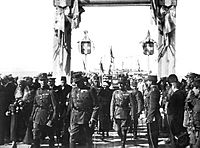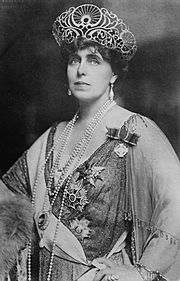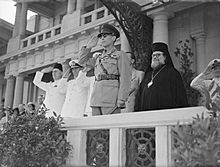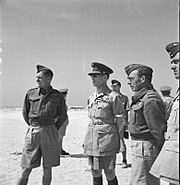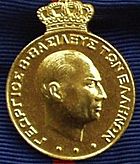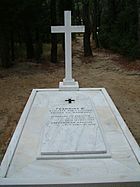George II of Greece facts for kids
Quick facts for kids George II |
|
|---|---|
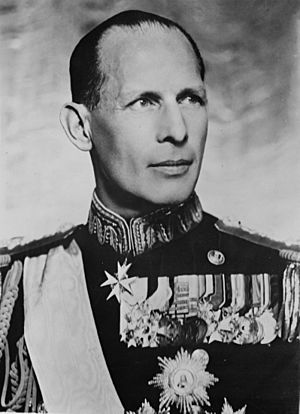
Photograph, c. 1942
|
|
| King of the Hellenes | |
| First reign | 27 September 1922 – 25 March 1924 |
| Predecessor | Constantine I |
| Successor | Monarchy abolished |
| Prime ministers |
See list
Anastasios Charalambis
Sotirios Krokidas Stylianos Gonatas Eleftherios Venizelos Georgios Kafantaris |
| Second reign | 25 November 1935 – 1 April 1947 |
| Predecessor | Monarchy restored |
| Successor | Paul |
| Prime ministers |
See list
Georgios Kondylis
Konstantinos Demertzis Ioannis Metaxas Alexandros Koryzis Emmanouil Tsouderos Sophoklis Venizelos Georgios Papandreou Nikolaos Plastiras Petros Voulgaris Archbishop Damaskinos Panagiotis Kanellopoulos Themistoklis Sofoulis Panagiotis Poulitsas Konstantinos Tsaldaris Dimitrios Maximos |
| Born | 19 July 1890 (O.S.: 7 July 1890) Tatoi Palace, Athens, Greece |
| Died | 1 April 1947 (aged 56) Athens, Greece |
| Burial | 6 April 1947 Royal Cemetery, Tatoi Palace, Greece |
| Spouse | |
| House | Schleswig-Holstein-Sonderburg-Glücksburg |
| Father | Constantine I of Greece |
| Mother | Sophia of Prussia |
| Signature | |
George II (Greek: Γεώργιος Βʹ, Geórgios II; 19 July 1890 – 1 April 1947) was the King of Greece. He ruled from September 1922 to March 1924, and again from November 1935 until he died in April 1947.
George was the oldest son of King Constantine I and Sophia of Prussia. He went into exile with his father in 1917. This happened after a big political disagreement in Greece. His younger brother, Alexander, became king instead. Constantine returned to the throne in 1920. But he had to step down two years later because of the Greco-Turkish War. George then became king. However, after a failed attempt by royal supporters in October 1923, he was sent to live in Romania.
Greece became a republic in March 1924. George was officially removed from his position and lost his Greek citizenship. He stayed in exile until the Greek monarchy was brought back in 1935. Then, he became king again. The king supported Ioannis Metaxas's government in 1936. This government was strong and nationalistic.
Greece was taken over by German forces in April 1941. This forced George into exile for a third time. He first went to Crete, then Egypt, and finally settled in London. There, he led the Greek government-in-exile. George returned to Greece after the war. A vote in 1946 decided that the monarchy should continue. He died in April 1947 at age 56 from a heart condition. Since he had no children, his younger brother, Paul, became the next king.
Contents
Who Was King George II?
George II was the King of Greece during a very difficult time for his country. He ruled twice, with periods of exile in between. His life was shaped by wars, political changes, and the challenges of leading a nation.
Early Life and First Time as King

George was born at the royal villa in Tatoi, near Athens. He was the oldest son of Crown Prince Constantine and Princess Sophia of Prussia. George chose a military career. At 18, he trained with the Prussian Guard. He then served in the Balkan Wars as part of the Greek Infantry. When his grandfather was killed in 1913, his father became King Constantine I. George then became the Crown Prince, meaning he was next in line for the throne.
During World War I, his father, King Constantine I, was removed from power. Crown Prince George, who was a major in the army, went into exile with his father in June 1917. This event was part of a big political split in Greece. George's younger brother, Alexander, was made king by the Prime Minister Eleftherios Venizelos and the Allied Powers. This happened because George, like his father, was thought to be too friendly with Germany.
King Alexander I died in 1920 from an infection after a monkey bite. After his death, a public vote brought Constantine back to the throne. Crown Prince George served as a colonel and later a major general in the war against Turkey. During this time, on February 27, 1921, he married his cousin, Princess Elisabeth of Romania, in Bucharest. She was the daughter of King Ferdinand and Queen Marie of Romania.
When the Turks defeated Greece in a major battle, the military forced King Constantine to step down. George then became King of Greece on September 27, 1922.
In October 1923, there was a failed attempt by royal supporters to take control. After this, a special committee asked George to leave Greece while they decided the country's future government. He agreed and left on December 19, 1923, going to Romania, his wife's home country. He did not officially give up his title as king.
George was a serious person. He had spent many years living outside Greece. This made him see Greece in a way that was more like how Western Europeans saw it at the time.
Living in Exile
The Second Hellenic Republic was declared by the Greek parliament on March 25, 1924. This was confirmed by a public vote a few weeks later. George and his wife, Elisabeth, were officially removed from their royal positions. They, along with other members of the royal family, lost their Greek citizenship. Their property was taken by the new government. They became stateless, meaning they had no country. Their cousin, King Christian X of Denmark, gave them new passports.
George and Elisabeth lived in Romania starting in December 1923. They settled in Bucharest. King Ferdinand and Queen Marie of Romania let them stay in a part of their palace for a while. Later, the couple moved to a smaller home. George and Elisabeth often attended royal events in Romania. Even though his mother-in-law was kind to him, George felt bored and without purpose in Bucharest.
Life in exile was hard for George and Elisabeth. They faced money problems and had no children. Their relationship became difficult. Elisabeth started spending a lot of time on rich food and gambling.
Becoming King Again and a New Government
After his mother died in 1932, George decided to leave Bucharest and his wife for good. He moved to London. He rented a small suite of rooms at Brown's Hotel in Mayfair. He lived there with his assistant and a loyal servant.
After the monarchy was removed in 1924, some leaders in Greece did not accept the new government. This question about the type of government lasted for over ten years. It eventually led to the monarchy being brought back. In October 1935, General Georgios Kondylis took over the government. He then arranged a public vote to approve his government and end the republic. On November 3, 1935, almost 98% of the votes supported bringing back the monarchy. Voting was required, and it was not secret. People felt pressured to vote for the king.
George, who had been living in London, returned to Greece on November 25. Soon after, he and Kondylis disagreed about a general pardon the King wanted. George then appointed a temporary prime minister, Konstantinos Demertzis. New elections were held in January. No single party won enough votes to form a government easily. This led to Ioannis Metaxas, a politician and army officer, gaining power. On August 4, 1936, George supported Metaxas in setting up a strong government, called the "4th of August Regime". This government ended parliament, banned political parties, and changed the constitution. The king and Prime Minister Metaxas led a government that arrested political opponents and controlled what people could say or publish. George preferred to let Metaxas handle tours around the country. King George kept full control of the army and made most decisions about foreign policy.
World War II and More Exile
Leaving Greece During the War
On October 28, 1940, Metaxas refused a demand from Italy to let Italian troops into Greece. This started the Greco-Italian War. The Greeks successfully pushed back the Italian invasion. But when the Germans invaded from Bulgaria on April 6, 1941, the Greek and British forces were quickly defeated.
After Prime Minister Alexandros Koryzis died on April 18, 1941, during the fast German advance, George became the leader of the government and the armed forces. He had a chance to form a broader government and end the strict regime. But George refused.
Instead, Emmanouil Tsouderos, a former head of the Bank of Greece, was chosen as the new prime minister. He was known for being friendly with Britain. On April 23, the King and the government left mainland Greece for Crete. Despite a brave defense of the island by Greek and New Zealand soldiers and local people against a German airborne attack, Crete soon fell. George was forced to leave again, first to Egypt. He then moved to Great Britain, just like in his earlier exile.
Life Away from Greece
During the time Greece was occupied by Axis forces, George remained the recognized head of state by other countries. He was supported by the Greek government-in-exile and the Free Greek Forces. However, British officials found George difficult to work with. He was very stubborn about keeping his royal powers. He did not want to make changes that would break away from the old government. He also resisted British pressure to promise to bring back the 1911 constitution. He felt that doing so would mean he admitted he acted wrongly in 1936. Even in 1942, George kept ministers from the old government in his cabinet. Under strong British pressure, George finally announced the end of the old regime in a radio broadcast on October 28, 1941.
George was a very worried and unsure person. He thought the British government was trying to stop him from returning to Greece. The British ambassador noted that the king's serious nature did not win him many friends. He said that George was a "reserved northerner" among the lively Greek people. One of George's few friends was the British Prime Minister Winston Churchill. Churchill wanted to see George return to Greece.
In occupied Greece, groups fighting against the occupation, like the National Liberation Front (EAM), became very popular. As the war ended, the idea of the King returning caused disagreements. Many people and politicians did not want him back because he had supported the dictatorship. In November 1943, George wrote to the prime minister-in-exile, saying he would "examine anew the question of the date of my return to Greece." This made it seem like he agreed to another vote on the monarchy.
After more political changes and a mutiny among Greek forces, it was agreed in May 1944 that the future of the monarchy would be decided by a national vote. George was against having a regent (someone who rules for the king). He tried to convince his friend Winston Churchill against Archbishop Damaskinos of Athens. On December 29, 1944, Churchill told the king that if he did not agree to a regent, the matter would be decided without him. George's private secretary said the king was very upset. But he eventually agreed to their demands.
George was forced to appoint Archbishop Damaskinos of Athens as Regent in January 1945. Damaskinos immediately appointed a government mostly made up of people who supported a republic. George, feeling tired and without power, rented a house in London.
Back to Greece and His Death
In elections held on March 31, 1946, parties that supported the monarchy won many seats. A vote on the monarchy was set for September 1. The results showed 68.4% in favor of the King's return. However, even observers from other countries noted that there was some unfairness in how the votes were counted.
On September 26, George returned to Greece. He found the Royal Palace had been looted, and the trees at Tatoi had been cut down for fuel. His country was facing big economic problems and political instability.
He died on April 1, 1947, from a heart condition. He was found unconscious in his room at the Royal Palace in Athens. When the news was announced, some people thought it was an April Fool's Day joke.
His funeral was held on April 6 at the Orthodox Metropolitan Cathedral of Athens. His younger brother, Paul, became the next king.
| Styles of King George II of the Hellenes |
|
|---|---|
| Reference style | His Majesty |
| Spoken style | Your Majesty |
Honours
 Kingdom of Greece:
Kingdom of Greece:
- Founder of the Order of St. George and St. Constantine, January 1936
- Founder of the Order of Saints Olga and Sophia, January 1936
- Commander's cross of the Cross of Valour, 28 October 1946
 Denmark:
Denmark:
- Knight of the Elephant, with Collar, 15 August 1909
- Cross of Honour of the Order of the Dannebrog, 15 August 1909
 France: Grand Cross of the Legion of Honour, 10 December 1892
France: Grand Cross of the Legion of Honour, 10 December 1892 House of Savoy: Knight of the Annunciation, with Collar and Star
House of Savoy: Knight of the Annunciation, with Collar and Star Monaco : Grand Cross of the Order of Saint-Charles, 11 April 1940
Monaco : Grand Cross of the Order of Saint-Charles, 11 April 1940 Poland: Knight of the White Eagle
Poland: Knight of the White Eagle Norway: War Cross Medal
Norway: War Cross Medal Romania: Collar of the Order of Carol I
Romania: Collar of the Order of Carol I Sweden: Knight of the Seraphim, 20 May 1919
Sweden: Knight of the Seraphim, 20 May 1919 United Kingdom:
United Kingdom:
- Honorary Grand Cross of the Royal Victorian Order, 20 July 1909
- Stranger Knight of the Garter, 7 November 1938
- Bailiff Grand Cross of St. John
- Companion of the Distinguished Service Order
See also
 In Spanish: Jorge II de Grecia para niños
In Spanish: Jorge II de Grecia para niños


